Rollers are huge construction machines that compress earth, concrete, gravel, crushed stone, or asphalt on construction sites surfaces. They are extensively utilized in road building and compact foundations on major construction sites and rely on their weight, combined with other mechanisms such as vibration and kneading, to compress the surface. There are different types of rollers ideal for different types of compaction.
The rolling method ensures that foundations are properly compacted and that materials are compact and do not come free, and road rollers are well-known in the building business. The road roller has several components, including diesel engines a canopy to protect the driver. This drum can be either vibratory or static, a compaction meter to measure the level of compaction, a water system, and tires.
Types of Rollers:
For soil compaction, various types of rollers are used. Contact pressure, number of passes, layer thickness, and roller speed are all elements that influence compaction. The following are some of the different rollers used on construction projects.
1. Cylindrical Roller:
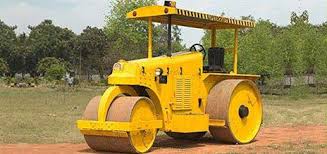
Fig 1: Cylindrical Roller
Courtesy: designingbuilding.co.uk
The most basic road roller, these rollers have the conventional cylinder drum and are either single drum rollers or two drum rollers, depending on the design. This road roller is commonly used to consolidate stone or similar materials into flat ground. These rollers work well when using surface dressings to create an even smoother and flatter surface.
Cylindrical rollers, normally made of iron, stone, or concrete and have a diameter of 1 meter, are primarily used for modest and private operations such as yard work.
2. Pneumatic Rollers:
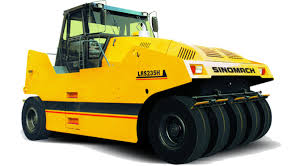
Fig 2: Pneumatic Roller
Courtesy: en.sinomach-hi.com
Compress pneumatic tire rollers use air to create the required inflation pressure. The contact pressure is determined by the contact area and the inflation pressure. The roller is usually made of 9 to 11 wheels mounted on two axles and fitted with pneumatic tires that provide complete coverage with each roller pass.
The rollers come in a variety of load capacities. The roller’s gross mass ranges from 5 to 200 Mg. Rollers having a mass greater than 50 Mg, on the other hand, are rarely used. The inflation pressure ranges from 200 to 1000 kN/sq.m. The rollers are available in both self-propelled and towed versions.
The kneading motion of the roller compacts the dirt. These rollers are capable of compacting both cohesive and non-cohesive soils. The ideal form of equipment for general use is these rollers. Soft rollers (mass up to 20 Mg) work well for compacting soil layers up to 15 cm thick, while heavier rollers work well for layers up to 30 cm thick.
3. Grid Rollers:
Grid rollers are a roller with a grid-like pattern on the steel drum created by a network of steel bars. The grid can be ballasted with concrete blocks or steel attachments for added contact pressure. . These rollers are usually dragged or carried behind a tractor or other heavy machine..
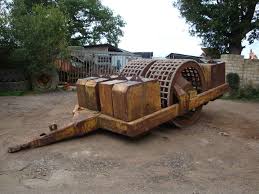
Fig 3: Grid Roller
Courtesy: bruceatfield.co.uk
On compaction activity, the grid pattern on the cylinder drum creates a high contact pressure with minimum kneading action. Grid rollers are used on well-graded, coarse soils, worn rocks, and subgrade and sub-base road projects because of this.
4. Sheepsfoot Rollers:
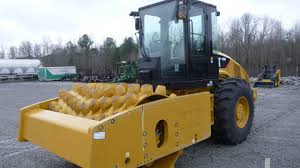
Fig 4: Sheepsfoot Roller
Courtesy: bruceatfield.co.uk
Sheepsfoot rollers, also known as tamping rollers, have multiple rectangular-shaped lugs, or “feet,” on them. They’re excellent for compacting soil and silly clay during road construction. The weight of the Sheepsfoot drum can be increased by ballasting it with water, damp sand, or fastening steel parts to it, making compacting more efficient.
This roller is used on wet clay or other fine-grained soils at great depths. You can use a pneumatic roller to finish off sections that Sheepsfoot rollers have compacted.
5. Static Roller:
Static rollers are divided into two categories, i.e., single drum rollers and double drum rollers.
i) Single Drum Roller:
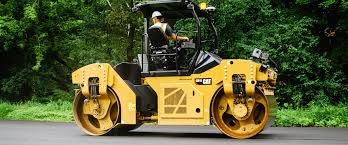
Fig 5: Single Drum Roller
Courtesy: catrentelstore.com
A single drum roller is a piece of heavy-duty equipment. A large drum can be found in the front, while unique tires found at the back. These tires are more durable and can avoid the majority of flats. You’ll need these heavy-duty tires when working on roads and construction sites. The driver is seated in the central portion of a single drum roller.
Modern variants come in three different conFig urations to accommodate varying surface compaction requirements. A high degree of performance and dependability is ensured by using world-class components. The design-for-quality principle can see in the reinforced front scraper, the sturdy 32 mm thick drum, and the turbocharger with pre-cleaner.
ii) Double Drum Roller:
The double drum roller, also known as a tandem roller, features one steel drum in front and one in back. The roller moves in lockstep with the two drums. The double drum roller’s efficiency is due to the two drums: large highway sections may be flattened and paved swiftly and efficiently.
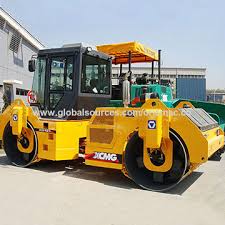
Fig 6: Double Drum Roller
Courtesy: globalsources.com
These rollers are excellent for flat or gradual surfaces such as asphalt, but they are not advised for anything specialized because of their lack of traction
6. Vibratory Rollers:
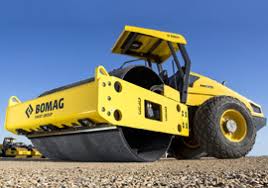
Fig 7: Vibratory Roller
Courtesy: roadsbridges.com
Vibratory Rollers are generally used to compact loose soil or asphalt in road and highway construction. These devices are frequently used on building sites for ground compaction and stabilization. Companies now make 10 to 12-tonne soil compactors and 3.5 to 9 tonne tandem compactors with innovative features. They are generally used for road and highway building to crush loose soil or asphalt. These devices are used on building sites for ground compaction and stabilization. We can now get tandem compactors with innovative features that weigh 3.5 tonnes and 9 tonnes.
Advantages of Rollers:
The following are the advantages of rollers:
- They’re safe to use.
- The road rollers have a lot of strength.
- The road rollers are used to create a finish that is pleasing to the eye and operates well.
- The vehicles are simple to operate, and the road roller is suitable for handling all of the project’s requirements.
Disadvantages of Rollers:
The following are the disadvantages of rollers:
- Rollers are expensive and
- Rollers pollute the environment.
Conclusion
For anyone looking to increase their performance, road rollers are a must-have. The trick is to pick one that meets the project’s requirements. The system exposed a great deal of strain, so it’s critical to start with a dependable solution. With the assistance of a high-grade road roller, ensuring optimal results is easier than ever before.
References
1. Inc., B. (2019, December 27). 6 Types of Rollers Commonly Used In Construction Projects | BigRentz. 6 Types of Rollers Commonly Used in Construction Projects | BigRentz. https://www.bigrentz.com/blog/types-of-rollers.
2. Different Types of Road Rollers Used In Construction – Constro Facilitator. (2021, January 13). Constro Facilitator. https://www.constrofacilitator.com/different-types-of-road-rollers-used-in-construction/.
3. Rollers | Types of Roller | Characteristics | Engineering Intro. (2012, July 3). Engineering Intro. https://www.engineeringintro.com/all-about-construction-equipments/rollers-types-of-roller-characteristics/.
4.Types Of Roller. (n.d.). Types of roller – Designing Buildings. https://www.designingbuildings.co.uk/wiki/Types_of_roller.
If you have a query, you can ask a question here.


